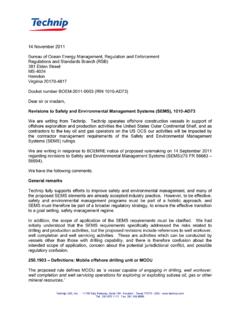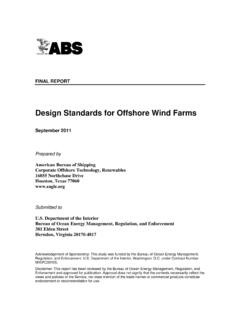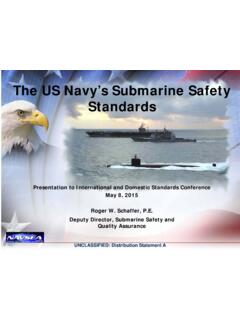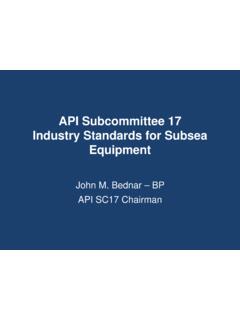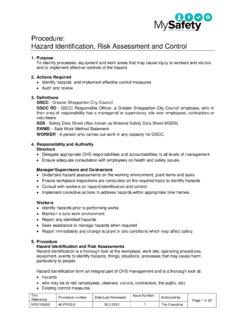Transcription of Probabilistic Risk Assessment: Applications for the Oil ...
1 Probabilistic Risk assessment : Applications for the Oil & Gas IndustryJoint Study by NASA and BSEE23 IntroductionProbabilistic Risk assessment (PRA) is a tool that has gained increasing popularity across several industries from nuclear power to human spaceflight to systematically and comprehensively evaluate risks associated with complex engineered Bureau of Safety and Environmental Enforcement (BSEE), in partnership with the National Aeronautics and Space Administration (NASA), is exploring the ability of PRA to assist in the evaluation and communication of risk in the offshore oil & gas the boundaries of exploration, development, and production facing challenges from harsher environments and new technologies, understanding the risks involved becomes more important than ever to ensure continued high levels of safety and environmental protection. By exploring the use of PRA, BSEE is considering the potential of PRA as a tool that can provide additional insights into the levels of risk involved in challenging offshore operations as well as facilitate communication with the industry on how to best manage those risks .
2 This paper presents a context for PRA in terms of current risk assessment practices in the industry, identifies the benefits of PRA, and provides a description of the PRA Context for Probabilistic Risk AssessmentConcept of Risk ManagementRisk management includes the principles, framework, and processes for managing risks effectively. Risk events are characterized as a combination of both the probability and consequences of undesired events. Therefore, risk management efforts are focused on a combination of the following: eliminating or reducing the probability of an undesired event; and reducing or mitigating the consequences of the undesired event should it occur. While many risk management practices are in use on the Outer Continental Shelf (OCS) and in the broader oil and gas industry, at their core they all follow the same process identify, analyze, evaluate, control, communicate, and monitor. Risk management for most offshore oil and gas operators begins with a multi-disciplinary approach to early well and facility design planning.
3 These planning processes are embedded within management systems that provide a framework for all of the operating and safety management activities of the organization. Organizational risk management processes are also provided within American Petroleum Institute (API) standards and recommended practices as well as International Organization for Standardization (ISO) standards. Qualitative versus Quantitative Risk AssessmentQualitative risk assessment is commonly based on experience or expertise and results in categorical estimates of risk. Quantitative risk assessment leverages empirical data to determine and assign numerical values to risks . Risk assessment activities are used to identify sources of risks , their causes, and consequences. Risk assessment techniques are selected, which may be qualitative or quantitative, to help decision makers better understand the risks . Risk assessment helps decision makers make informed choices, prioritize actions and distinguish among alternative courses of action.
4 Finally, decisions are made to determine if existing risk controls should be modified or additional controls added to provide further prevention or mitigation of the appropriate risk assessment approach or combination of approaches is a key step in supporting the decision-making process, where options are evaluated against the risks associated with each choice. Both qualitative and quantitative risk assessments provide decision makers with the knowledge required to properly control and communicate the risk. Selection of a suitable risk assessment approach should reflect the evaluation of the technical and operational challenges. Qualitative assessments, involving expert judgment, may be sufficient for many operations, such as Not every situation requires a quantitative approach; however, PRA is appropriate for complex engineering hardware that has critical human interaction and multiple pathways to catastrophic assessments are effective at identifying many risks and consequences associated with oil and gas exploration and production.
5 Companies have used these results to successfully develop and implement risk management and safety programs. While effective at identification of the hazards, qualitative assessments do not quantify the probabilities of events, and therefore, make assigning any type of risk rating subjective and often difficult. Low probability , high consequence events are not defined as well as they might be with more quantitative methods. Quantitative assessment Quantitative risk assessment involves the assignment of data-supported numeric values in the assessment of probability and consequence. It commonly follows an initial qualitative assessment , focusing on the highest-priority risks identified. Quantitative risk assessment can account for the simple operations where the level of risk is dependent on fewer variables and where uncertainties are relatively low. Quantitative assessments, however, can offer additional insight when the operation or technology is more complex; decisions regarding the effectiveness of risk controls and potential consequences are dependent on many variables; multiple paths to failure exist; the magnitude of risk is greater; or uncertainties are higher.
6 Ultimately, choosing the appropriate risk assessment method is also for proper communication of risk between the operator, the regulator, and other AssessmentQualitative assessments are commonly used in oil and gas risk management and are valuable first steps in the risk analysis process. They add rigor and structure to the common risk assessment method of brainstorming. Examples of qualitative assessments can include:Hazard Identification (HAZID)HAZID is a structured brainstorming technique for the identification of all significant hazards associated with the particular activity under consideration. Usually conducted in the beginning of the project, it is the starting point to conducting qualitative assessment of major accident and Operability (HAZOP)HAZOP is a systematic approach to identifying hazards and operability problems in design and operations occurring as a result of deviations from the intended range of process conditions.
7 Complex designs usually are assessed as a series of smaller AnalysisBowties are a visual risk assessment method focused on a single event and the threats (cause) and consequences (effect). They are more commonly used to analyze major accident events such as loss of containment, facility explosion, fire, etc. Bowties can illustrate relationships between hazards, controls and an organization s safety management systems, otherwise known as barriers. Failure Modes and Effects Analysis (FMEA)FMEA is a subjective analysis of facility equipment, potential failure modes and the effects of those failures on the equipment or facilities. The failure mode is simply a description of how the equipment failed. The effect is the incident, consequence or system response to the Hazard Analysis (JHA)JHA is a hazard analysis of a completed procedure to identify any additional hazards to people or process prior to putting it in the field. In some cases, JHA is a general job-related safety of effects between multiple scenarios or events, as with the Quantitative Risk assessment method briefly described in the table below.
8 The method accounts for compounding effects by quantifying the possible outcomes and the probability of their occurrence, allowing risk-informed decision-making in the presence of uncertainty. There are multiple methods for performing quantitative risk assessment and many are used regularly in the oil and gas industry. Some common quantitative approaches include:Layers of Protection AnalysisSemi-quantitative method that analyzes one incident scenario (cause-consequence pair) at a time, using predefined values for the initiating event frequency, independent protection layer failure probabilities, and consequence severity, in order to compare a scenario risk estimate to risk criteria for determining where additional risk reduction or more detailed analysis is needed. Scenarios are identified elsewhere, typically using a scenario-based hazard evaluation procedure such as a HAZOP Mode & Effect Criticality Analysis (FMECA)A variation of FMEA that includes an estimate of the potential frequency and severity of consequences of a failure mode.
9 FMECA can be both qualitative and quantitative based on the approach. The Quantitative FMECA uses a Quantitative Criticality Analysis and the Qualitative FMECA uses a Qualitative Criticality Analysis. Event Tree AnalysisGraphical model represents the various event chains that can occur as a result of an initiating event. Used quantitatively to determine the probability or frequency of different consequences arising from the hazardous event. (May be used in PRA.)Fault Tree AnalysisGraphical model representing various combinations of equipment failures and human errors that can result in system failures or hazardous events. Output is a failure-logic diagram based upon Boolean logic gates. Used quantitatively to allow system-failure probability or frequency to be calculated. (May be used in PRA.)Quantitative Risk assessment (QRA)The systematic development of numerical estimates of the expected frequency and severity of potential incidents associated with a facility or operation based on engineering evaluation and mathematical techniques.
10 QRA s have traditionally been utilized to quantify risks in the design and operation of offshore installations to predict and quantify the direct effects of dispersion of gas or released fluids; overpressures due to explosions; size and duration of fires; structural impact from collisions, falling objects; and escape, evacuation and rescue capacity during major accident event Risk assessment (PRA)PRA is a systematic and comprehensive methodology to evaluate risks associated with every life-cycle aspect of a complex engineered technological entity. PRA involves the assignment of numeric values in the assessment of probability and consequence, and commonly follows an initial qualitative analysis, focusing on the highest-priority risks identified. It allows for the compounding of effects between multiple scenarios or events. It does this by quantifying the probability of possible outcomes allowing risk-informed decision-making in the presence of uncertainty.
